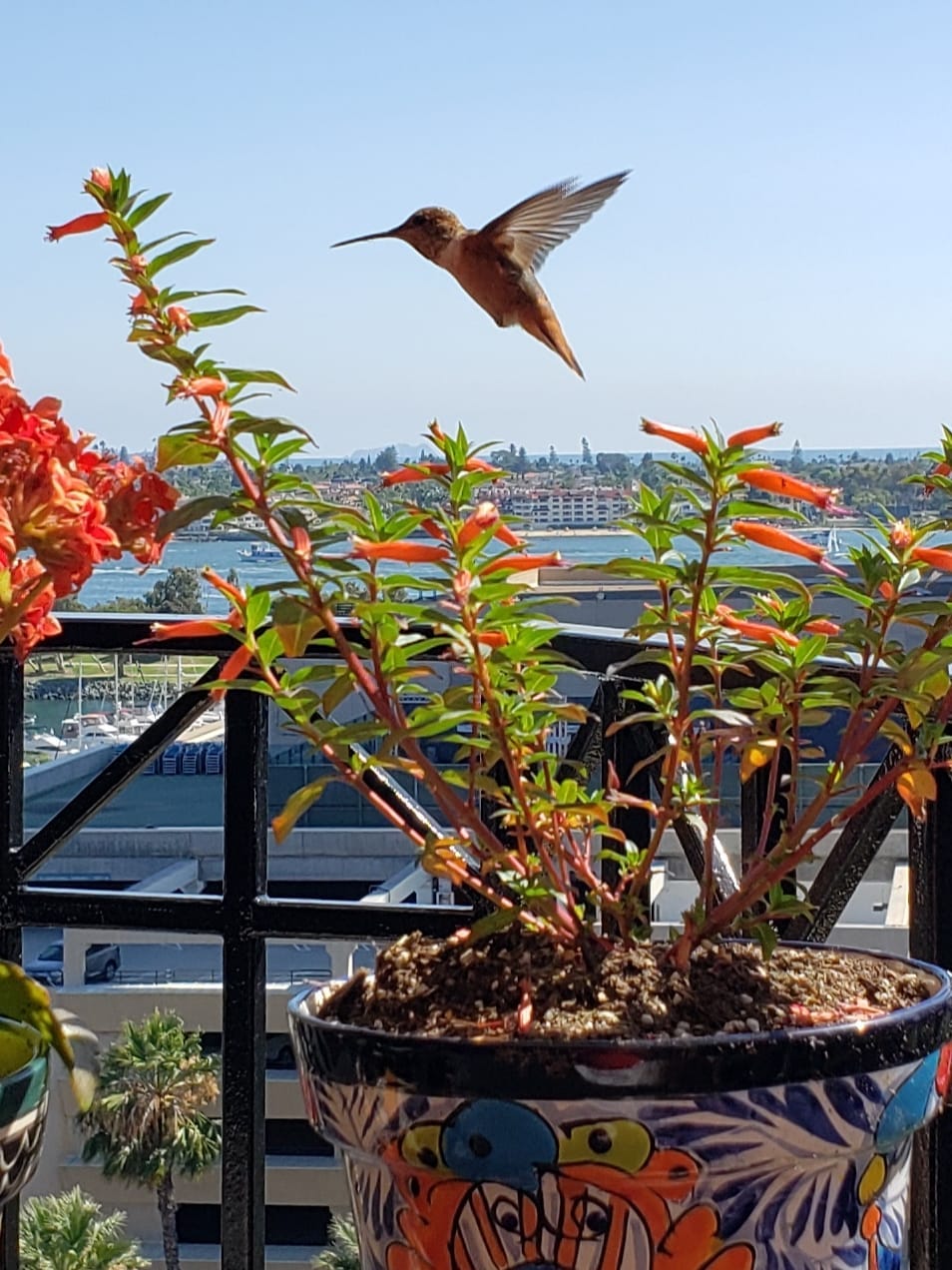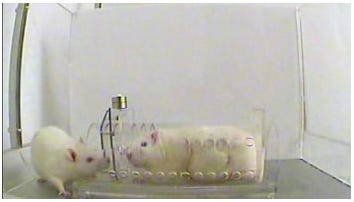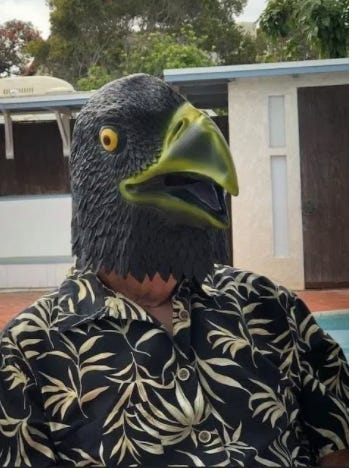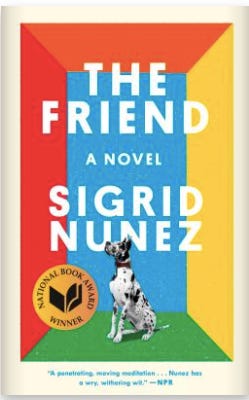“Humans are a strange lot. We have the power to analyze and explore the world around us, yet panic as soon as the evidence threatens to violate our expectations.”
― Frans de Waal, “Are We Smart Enough to Know How Smart Animals Are?”
So, how smart do you think you compared to, say, the skunk who ravaged your garden last night? Or the this beautiful hummingbird who has made my friend Tom’s patio a regular pitstop on its rounds of downtown San Diego?

(Photo by Tom McFarland)
The more I read about the intelligence of animals, the more I realize that I’m not as smart as I thought I was. I’m relieved, actually. I am exhausted from trying to balance on the tiny tip of the pyramid we humans invented for ourselves.
In fact, the more I read about the intelligence and capabilities of animals, the more I realize animals can tell me things about myself and the other members of my species.
This the reason I could not put down Frans De Waal’s book, “Are We Smart Enough to Know How Smart Animals Are?” when I got it a couple of years ago for research on my novel-in-progress. It is the reason I dove into his follow-up book, “Mama’s Last Hug: Animal Emotions and What They Tell Us About Ourselves” when it came out last year.
I came upon these books after a late-in-life love affair with a few special dogs. They showed me that language was not proof of intelligence. The dependence of my pets did not obscure their ability to learn, innovate, and read me like an open book. Interestingly, the more I learned about their body language, tone, and responses, the more I noticed how much my fellow “two-leggeds” communicated in similar ways.
Once, on a walk along a narrow stretch of the cliffs with my old Cairn terrier, Chloe, I watched two middle-aged men encounter each other at the narrowest point bordered on each side by fencing. Neither one made direct eye contact. Neither one turned sideways to let the other pass. Instead, they squeezed past each other, shoulders brushing just enough to confirm something for the other or themselves. No words passed between them but a great deal of communication had taken place.
In his books, De Waal peeled away what remained of my assumptions about human superiority and he did it with imagination, creativity, wonderful case examples memorable characters, and humor. The first section is called On Becoming a Bug and opens with a vivid recap of the character Gregor Samsa who wakes up in the form of a cockroach in his Kafka’s work, “The Metamorphosis.” Next thing we know, we’re thinking about animals from their point of view instead of ours, a view advanced by a German biologist named Jakob von Uexkull and one resisted for years by many scientists. Not many pages later, De Waal has already imparted beautifully and painlessly how misleading it is to try to establish cognition — the ability to acquire, process, and apply knowledge — as something only we and maybe other primates like bonobos or chimpanzees can do.
Measuring animals by human standards ignores their environment, their bodies, and the skills and capacities they have developed to thrive. As De Waal puts it, “It seems highly unfair to ask if a squirrel can count to ten if counting is not really what a squirrel’s life is about.” On the other hand, he points out that squirrels and many species of birds can hide tiny seeds in hundreds of different places for future use and retrieve nearly all. I can’t even keep track of my reading glasses.
Even when scientists have been willing to acknowledge the capabilities of primates, our closest nonhuman relatives, they have been much slower to acknowledge the capabilities of other species. De Waal points out Alex, the famous African gray parrot, as an example. Alex’s memory along with his ability to differentiate objects he’d never seen before and use language to communicate was met with consistent skepticism for much of his life because of entrenched ideas about the relative intelligence of birds versus primates.
“There are many ways to process, organize, and spread information, and it is only recently that science has become open-minded enough to treat all these different methods with wonder and amazement rather than dismissal and denial.” - Frans De Waal, “Are We Smart Enough to Know How Smart Animals Are?”
The Human Costs Of Getting it Wrong
Alex notwithstanding, animals don’t use language in a way we recognize. For many years, scientists assumed this meant they lacked cognitive ability and even the ability to feel. Animals have routinely suffered for this but they are not the only ones. Human babies don’t speak either and, incredibly, this was interpreted for many years to mean the infants don’t have a nervous system developed enough to feel pain. In “Mama’s Last Hug” De Wall shares this horrifying factoid:
…because babies can’t talk, it was assumed that their ability to feel pain was similarly undeveloped. That is why until the 1980s, many doctors performed surgery ranging from circumcisions to more invasive procedures without pain-killing anesthesia. They used curare, a muscle relaxant which did nothing to prevent pain but conveniently prevented children from resisting.”- Frans De Waal,
“Mama’s Last Hug: Animal Emotions and What They Tell Us About Ourselves”
Thankfully, we’ve advanced but this raises the issue: why would we assume that because another species lacks language, they can’t communicate, think, or feel pain? Animals can not only feel their own pain, they can empathize with the pain of others in their circle and respond. In “Mama’s Last Hug,” De Waal mentions this study among many others as an example in which the free rat would neither rest nor accept a treat of chocolate until he’d freed his cage mate. You can watch them by clicking on the photo below.

Even now, years after many scientists debate the extent to which animals possess emotions and are capable of responses like empathy, anger, disgust, fear, affection, or laughter. Yet throughout “Mama’s Last Hug,” De Waal shows over and over again that nonhuman animals display all of these if we take the time to look and if we are willing the shed our human egos. We don’t have to look far before seeing qualities we recognize. For example if you think humans have a lock on justice and fair treatment, watch this:
I wonder, what do we think we will lose if we recognize that animals have the capacity to think, to feel, to make decisions? Or, is it that we have failed to use the capacities we have and simply can’t abide the idea that a squirrel or a rat or the dog prancing by our sides might understand things we never will?
If you’d like to learn more from Frans De Waal but don’t have time to read the books right away, here’s an interview with him in The Sun Magazine and a link to his TED Talk.
Short Read: The Woman and The Squirrel
My friend from back east told me the other day of an ongoing conversation she’s been having with a squirrel. She evicted him or his near relatives from her attic last winter but heard the sound of teeth gnawing wood one recent afternoon as she watered her garden. She glanced up at her eaves and sure enough, there he (or she) was, chewing through the special one-way window she’d had installed to keep him outside.
“Hey,” she said. “Hey!”
A brief suspension in the chewing, then it resumed. She finished watering her veggies and then adjusted the stream of the hose. She gave the squirrel one more chance.
“Get. Down. From. There.” The squirrel barely glanced at her.
She aimed the hose and sprayed a jet that goosed the rodent and sent him fleeing down the nearest tree.
Then, two days later, she was back in her yard and he was back at the eaves, sharpening his teeth on the wood, trying to make a hole. But this time, when she said “Hey!” the squirrel stopped chewing and peered down at her. She walked over to the spigot and placed her hand on it. The squirrel scampered across the roof and dove down the tree.
She calls it progress. I call it more proof that words are not necessary to establish a creature’s intelligence. But I’m betting that squirrel will be back. To be continued.
Local News: The Crows And Mr. X by Judi Curry
What would make a man do this? Read this short series by Judi Curry, a columnist in one of our local papers, the OB Rag to find out just how smart and vengeful crows can be when they believe they’ve been wronged. The Crows Part I and The Crows Part II.

Fictional Animals
Two cat stories by Jim Ruland
“Great, while my ex was getting ready to marry a minor celebrity, I was sleeping on futons and talking to cats.” - Jim Ruland, Cat Sitting in Hollywood
“I leap into the tall grass behind the gas station, hoping to find something that doesn’t want to be found, any excuse to put my claws to use. The body inside the Winnebago has me spooked.” - Jim Ruland, Winnebago
And Sigrid Nunez’ Novel, “The Friend’” This is about a Great Dane but really it’s about a woman and the dog and the aftermath of a friendship. It’s funny. It’s sad. Every word serves its purpose. Sigrid Nunez’ “The Friend” is one of the best books I’ve ever read.

That’s it for this week. Thank you for your indulgence.
Tell me about the smartest animal you ever met and don’t forget to tell me how you are and what you are reading so we can add the titles to our recommendations for everyone at our page on bookshop.org. If you come across a great clip in your local newspaper, send it along so we can share it. You can use this button (see note at end of this issue if you have problems with that).
And if you’re browsing for a book, check out the ones everyone is reading here at our bookshop.org page where every purchase supports local bookstores and supports literacy.
Gratefully yours,
Betsy
And now… your Moment of Zen
Mama’s Last Hug
A few words about the comment button above. If you click it, it is supposed to take you to the comments section for this post. If it doesn’t, don’t despair. Simply scroll to the end and hit the little chat icon next to the heart and that should work. A reminder: you may be asked to register with the site so they know you are not a bot. After you register, they won’t bug you again. If you press it and don’t get anywhere, please tell me! I am trying to get this right with the folks at Substack and every bit of info helps. My main hope is that we will be able to use the comments to continue our conversation. Thanks so much. B.




Wonderful newsletter packed with so much good writing and thought. As for that squirrel, yes she will no doubt persist. It’s mating season again and that means building a nest. But I’m glad she and I understand each other.
Lovely post! We've been "communicating" with the beetles, dragonflies, hummingbirds and crows we see from our patio. And thank you for linking to my cat stories!